Well boys and girls, I’m two weeks into a Magic odyssey that will encompass seven weekends—assuming I stop procrastinating and book my ticket for GP
Dallas. I’ve taken some time out of packing for my next trip and catching up at the office to deliver you more statistics. Over the past couple
weekends, Star City Games ran a couple of small tournaments you might have heard of in Washington, D.C. and Edison, NJ. Oh, what’s that? We had almost
700 and 600 players at each respective Standard event? And we broke the record for Legacy attendance at both events? As you might imagine, everyone’s
pretty excited about those two events, and we’re all eager to bust those new records as quickly as possible. Of course, the incredible attendance also
adds a bit of time to this column, but Jared and I are happy to slog through it for you guys.
Considering the victory of Time Spiral in Edison, I expect that the Legacy metagame is about to change in no small way, but you can’t figure out where
you’re going without knowing where you’ve been. Today’s TMI will cover Indianapolis, DC, and Edison, combining the results from these relatively
similar metagames. I feel inclined to point out that combo was slightly more popular in Edison, but the difference was not absurd, and the diversity
level is still very high, masking any irregularity. The numbers I consider most important are the matchups, and having more matches to back each result
will definitely give us more reliable results. Without any further ado, off to the maths! Click here for the full spreadsheet.
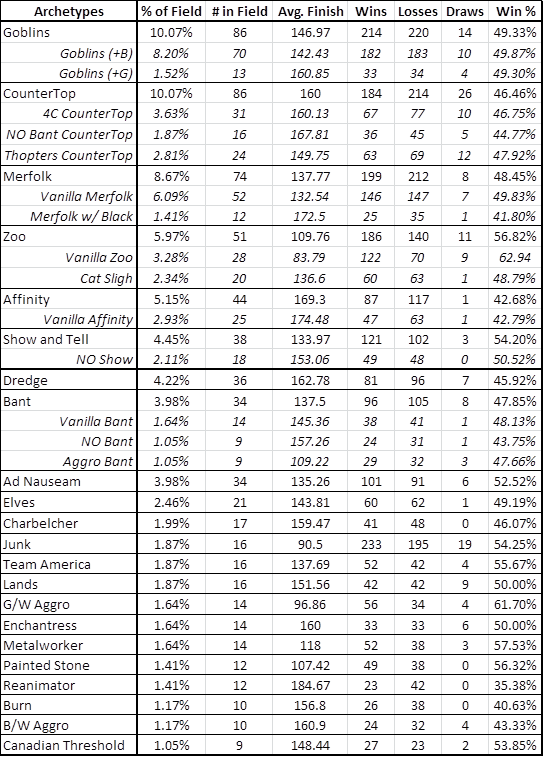
This chart has plenty of interesting information. There’s the usual mass of archetypes gathered between 1-2%, and the top is pretty spread—no archetype
broke much past 10%, but that’s not so unusual for Legacy. The top three played musical chairs as expected, with Merfolk falling to the bottom as
Goblins and Counterbalance both experienced success in turn. The big story has to be Zoo, which is surging in popularity and in success. On the smaller
scale, Natural Order is growing more and more popular as a potent endgame because it gives players a cheap way to access both Terastodon and
Progenitus, providing a cheap solution to your opponent’s permanents or life total. I doubt this engine will become less popular anytime soon, so grab
your Natural Orders while you can.
Tier 1, as usual, will include only the archetypes that have claimed more than 5% of the field. For the matchup discussions below, I’ve continued to
chart the most relevant sub-archetypes when they exceed the popularity of their peers by a high enough amount. Generally, if a sub-archetype comprises
more than 70% of its category, you’ll be batting well to assume that your opponent is on that version. For example, Goblins is very likely to be
splashing black, and Merfolk has reversed course and steered back to the clearer waters of mono blue, for now. CounterTop, of course, comprises far too
random a sampling to bother testing each individually, and each sub-archetype is a small piece of the metagame pie anyway. I don’t expect this to
affect the reliability of our information much, and if you’d like to check on the major archetypes without this simplification, you can do so using the
chart found here.
Goblins — 10.07% of the Field — Won 49.33% of Matches
Best finish:Â Max Tietze, 5th place — DC Legacy Open
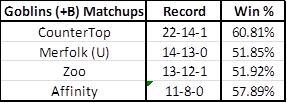
Oh, Goblins. After winning a pair of Opens to kick off the new year and performing admirably in subsequent events, players have clearly begun to adapt
to the little buggers. Naturally, you don’t notice that in the matchup chart above, as Goblins put up those initial finishes because it was a very
strong deck against the top of the field. Since then, a lot of CounterTop and Merfolk players have been jumping ship for other archetypes, depriving
their Goblins opponents of the usual edge.
Even the Lord of Atlantis himself, Alex Bertoncini, was spotted playing something else in Edison, NJ. When Drew Levin won’t sleeve up Counterbalance
and Alex strays away from Merfolk, you know that it’s time to examine the metagame anew. A lot of Legacy ringers like Drew and Alex loved to play decks
that happened to lose a lot of margin against Goblins, which made Goblins a great choice for making up the lost edge in skill. That deck-choice snafu
made it much harder for stronger players to bash their way through a tournament on the back of their superior play. Calling an audible solves that
problem!
Goblins does not fare well when people start gunning for it. While it is a tactically resilient deck thanks to its ability to switch roles over the
course of a game, it does not pack a particularly fluid game plan or significant disruption. Combo decks like Ad Nauseam and Show and Tell can have
their way with most Goblins opponents as long as they’re careful, and a lot of other decks can crush the red menace with inclusions like Engineered
Plague. It’s not a coincidence that we’re seeing Enchantress and Thopter/Sword decks suddenly performing in these tournaments—Enlightened Tutor for
Moat, anyone? Even Ensnaring Bridge can be a major pain for this tribe.
Following Alix Hatfield’s High Tide-fueled victory in Edison, I expect Goblins to become an even poorer choice. In its current iteration, Goblins can’t
handle the sudden influx of combination decks—and they’re not real happy to see all these Zoo decks, either. If you’re intent on playing Goblins, find
some technology to help you beat these opponents.
CounterTop — 10.07% of the Field — Won 46.46% of Matches
Best finish: Ben Wienburg, 1st place — Indianapolis Legacy Open
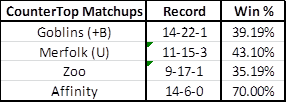
The card Counterbalance is not a happy camper right now. In spite of a nice weekend in Indianapolis, the emergence of Natural Order and the growing
popularity of Goblins have made it real tough on anyone looking to reveal the top card of their library. Most of these decks are simply different decks
with the Counterbalance engine tacked on for good measure. Ben Wienburg tournament-winning list from Indianapolis leaned on Grim Lavamancer for an
edge in Tarmogoyf fights and to help him beat all those silly creature decks, much like Canadian Threshold. Josh Guibault’s list built to abuse
Enlightened Tutor actually managed the game pretty aggressively with its high-powered permanents, and used the Counterbalance engine to shut the door
on opponents when the opportunity presented itself. The more diverse the metagame, the worse Counterbalance becomes, and Legacy is a wide-open field
right now. Many Counterbalance aficionados are leaving the skill-intensive strategy behind for something with more oomph to it.
Legacy tournaments are also growing longer—as attendance increases, so will round counts. A mentally strenuous deck like Counterbalance is a very real
handicap in tournaments like these. Staying mentally fresh is important to playing at the top of your game, so don’t underestimate the effect of game
length on your deck choice. If you can’t play and think quickly, then a deck that revolves around a ton of shuffling and Sensei’s Divining Top
manipulations will literally steal a fifth of your round from you.
A draw is as good as a loss when taken early in a tournament like the Edison Open, so be careful. A slow player who picks up multiple draws after
choosing a glacial deck doesn’t have much to complain about. If you’re sleeving up a Counterbalance deck for the Memphis Legacy Open, I’d encourage you
to playtest with a clock in effect while at home, as it will help you get used to the pace of your own decision-making.
For what it’s worth, I personally love the Enlightened Tutor variants of Counterbalance and find Thopter/Sword pretty interesting. Maybe there’s even
room for Stoneforge Mystic in Legacy . . .
Merfolk — 8.67% of the Field — Won 48.45% of Matches
Best finish:Â Alex Bertoncini, 8th place — Indianapolis Legacy Open
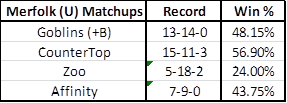
Well, it turns out that you can go back. Mono-Blue Merfolk was the resounding favorite among Merfolk players over the past few weekends, and I’m not
surprised. I’ve cited the poor performance of the black variety relative to its performance, but in reality this is just a terrible time to be playing
Merfolk at all. You’ve got a couple of things going for you: Counterbalance is still relatively popular, Doomsday and Ad Nauseam are both catching on,
and Goblins should be dying out a bit. However, Zoo is only growing more popular, and the Show and Tell decks are growing capable of fighting off the
webbed menace. As I noted before, Alex Bertoncini called the audible—that should tell you something! Check his history in our deck database, and you’ll
note that every relevant Legacy finish he’s ever made has been with Merfolk, and he didn’t like the black much either. If the format convinced Alex to
put down the Cursecatchers, then I’d advise you to consider doing the same.
Zoo is good, guys—Wild Nacatl will eat your face.
Zoo — 5.97% of the Field — Won 56.82% of Matches
Best finish:Â Kemper Pogue, 7th place — DC Legacy Open
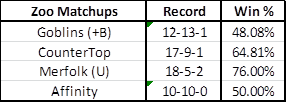
Ben Wienburg has been wondering where Zoo went for weeks, and it looks like players have finally found it. Survival mashed this deck into extinction,
but with no Survival around, all bets are off. Green Sun’s Zenith has provided the archetype with an unexpected boost following Mirrodin Besieged, and I think we’ll be seeing even more from the card in coming weeks. Offering virtual copies of Knight of the Reliquary and
Qasali Pridemage is really strong, and the Zenith even lets players do the same with Gaddock Teeg and other green creatures you might normally relegate
to the sideboard. As a threat that dodges Counterbalance, Zenith has proven itself to be quite strong, and I expect it to live up to the hype and be a
major player across multiple formats for some time. The card has yet to be fully explored in Legacy, but everything I‘ve seen thus far has been
exciting.
The lists with Zenith tend to also include Sylvan Library, which naturally shares a certain synergy with the sorcery. Kemper Pogue’s Top 8 list from DC is very cool, although I might rework the
sideboard a fair bit. Mary Jacobson list from that same
tournament includes a preponderance of burn with some disruption, but I don’t think that’s where you want to be right now. Players are getting smart,
and as they build their decks to dodge Wasteland, they’ll also be prepared to fight off Price of Progress and Magus of the Moon. I’d prefer to try and
beat every creature deck I can, and lean on my toolbox and Mindbreak Traps against everything else. It’s not the best plan, but it seems like a
playable one.
At least, that’s what I’d do if I was going to sleeve up Wild Nacatls. But why would I do that?
Affinity — 5.15% of the Field — Won 42.68% of Matches
Best finish:Â Michael Eisenhauer, 8th place — Edison Legacy Open
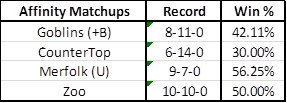
I’ve never really been an Affinity guy. I’ve generally refused to believe that the deck was good ever since its departure from Standard, and it’s just
not the sort of deck I advocate playing. It’s basically a tribal linear that doesn’t even get to be a sweet Aether Vial deck anymore. The idea of
playing against a Firespout or a real combo deck just gives me the willies, and dropping little artifact dudes isn’t really my idea of a good time. I
respect that other people find what this deck does to be enjoyable, but I don’t share their attraction.
Its performance against Tier 1 is pretty abysmal, and I can’t imagine it improves much against the various combo decks even with its Canonists and
Thoughtseizes out of the board. One of the elements of this archetype I dislike the most is its inability to extensively sideboard without tearing
itself apart. You can’t just jam whatever you want in there—your deck has a delicate balance. I respect Mike Eisenhauer double-header achievement,
but I am not prepared to welcome Signal Pest into Legacy. Nothing that Affinity does seems much more impressive than Goblins, and Goblins boasts better
matchups at the cost of the occasional blazing draw. A build that takes advantage of Tezzeret, Agent of Bolas or Thopter/Sword and proves itself
capable of actually playing some Magic could be quite entertaining, but I don’t think it would be much more than a Tier 2 strategy at this juncture.
And now for a few choice selections from the fringe.
Metalworker — 1.64% of the Field — Won 57.53% of Matches
Best finish: Michael Bomholt, 2nd place — Indianapolis Legacy Open
When we first saw Kuldotha Forgemaster debut in Indianapolis, there were whispers of Grim Monolith and Metalworker forming the backbone of a new deck
to beat. It certainly performed convincingly in the quarterfinals and semifinals, smashing the opponent with early Wurmcoil Engines before falling to
Ben Wienburg on the back of some mediocre draws in the finals. I’ve lumped similar archetypes together under our chart for the purposes of analysis, as
the decklist differences are minor. Since then, the deck has done fine, but nothing really spectacular. Many players have compared it to Charbelcher,
noting that it can win without the blowout combo finish—but that its blowout combo doesn’t nug the opponent for the full amount and is thus less
potent.
I think there’s a strong deck in here somewhere, but no one has found it just yet. Ancient Tomb is quite a land, after all.
Natural Order/Show and Tell — 2.11% of the Field — Won 51.04% of Matches
Best finish: Josh Rayden, 8th place — Indianapolis Legacy Open
One of the most entertaining decks to watch develop has been this archetype, which I have affectionately dubbed “NO Show.” Why? Mostly because it
rhymes, and I can. AJ Sacher first played this deck to a solid finish at GP Columbus when he noticed the convergence of mana creatures, Natural Order,
and Show and Tell as an effective way to stick a fatty on the quick. Josh Rayden logged a Top 8 finish with the archetype in Indianapolis, and AJ
himself has fallen just short twice since adding Green Sun’s Zenith to the deck as a mana and tutoring engine. I think the deck is a
real contender, and it looks fun and versatile, which are my two favorite qualities in a deck.
High Tide — 0.82% of the Field — Won 66.95% of Matches
Best finish: Alix Hatfield, 1st place — Edison Legacy Open
For a deck that no one wanted to acknowledge as real—or even good—High Tide has come a long way. Not many players have played it, but their
performances have been pretty strong. A few Top 16s along the way to Alix Hatfield’s Edison win have proven that this deck is very powerful and that it
will affect the metagame. While the cost of Candelabra of Tawnos will affect the archetype’s playability for some, the raw power of casting a Time
Spiral remains appealing.
I watched Alix Hatfield play a lot of Magic last Sunday—and by “play a lot of Magic” I mean I watched him cast High Tide and spells while his opponents
stared at their Tarmogoyfs. The only reason Eli Kassis was even in that final was thanks to an above average number of Hymns to Tourach per game—don’t
dismiss Alix’s win as topdecked tomfoolery. That’s just what Time Spiral does.
I’ll see you again soon—there’s plenty of Standard on the way and even more Legacy in about a month. If you’re in Memphis and doing well with a sweet
brew in Standard or Legacy, feel free to find me, and let me know. I’m always on the lookout for Deck Techs, and it might land you a spot on SCGLive! Don’t forget to follow @SCGLive for the latest updates live from Memphis, and tweet back.
–Glenn Jones
Coverage Content Manager
